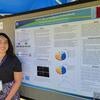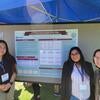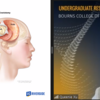UCR Undergraduate Research & Creative Activities Symposium
2024 Symposium Dates:
May 7-9 Virtual Oral Presentations
May 10 In-Person Poster Presentations
Mission
To celebrate undergraduate research and creative activities across all disciplines at UCR, and provide a positive learning experience for presenters and guests.
Poster and Oral Presentation Guidelines
Research and scholarships are usually presented at either the oral or the poster sessions. Students should consult with the faculty mentor to determine the most appropriate track for presenting their work prior to submission. Undergraduate students should apply to present their research using one of the following tracks:
- TRACK 1: POSTER PRESENTATION A poster presentation should concisely communicate research using graphics/images/figures with minimal text. A 5-7 minute explanation will guide the audience through the research topic, methodology, preliminary/expected results, and conclusion/next steps.
- TRACK 2: EMERGING RESEARCH (ORAL) Emerging research presentations should represent research projects that are not completed but might be of significant interest to the research community. Both conceptually- and empirically-based papers on "work-in-progress" projects would fall into this category.
- TRACK 3: COMPLETED RESEARCH Completed research presentations should represent fully developed empirical research. This track is open to papers based on completed research studies. Students should be able to clearly present their research question, outline the research methodology and assessment, and present clear outcomes.
- TRACK 4: CREATIVE ACTIVITY Creative activities and performances should represent the final product of scholarly creative activity. These projects could include, but are not limited to, submissions from Dance, Art, Music, Creative Writing, Media and Cultural Studies, and Theatre, Film, and Digital Production. Students should be able to discuss the research/inspiration behind the final product. Performing and visual arts projects may be presented in the traditional oral or poster format, or as exhibits, displays, performances, readings, and viewings.
Abstract:
Prior to submission, students should consult with their faculty mentor to develop a 250-word abstract, which should meet the following formatting requirements:
- Word document (.doc or .docx format)
- Abstract title and student name on the top of the page
- Document size cannot exceed 3 MB
- 12-point Times New Roman font, single spaced
- 1-inch margins on all sides
- Abstract expectations presentation
How to write an abstract workshops:
- In-Person: TBD
- Zoom: TBD
When uploading your abstract you must follow the format noted below. Abstracts not following this format will not be considered.
Top Left:
- Presenter: Name (first, last), Major
- Faculty Mentor: Name (first, last), Department
- Secondary Presenters or Contributing Members: Name(s) (first, last). Please list in the order of contribution.
- Project Title:
- 250-word abstract
Online Presentation Guidelines
-
Emerging Research Guidelines
Emerging Research presentations are allotted 8-10 minutes to speak about the research or project, followed by a three to five-minute question and answer session facilitated by a faculty moderator.
- Zoom is the platform that will be used for presentations.
- It is encouraged that you rehearse your presentation in front of an audience and ask your practice audience for feedback using Zoom. Speak clearly into the camera, project your voice and make frequent eye contact with the camera. Remember the general outline of your presentation and the logical order of information.
- Make sure that you have a clutter-free background. A plain wall is ideal.
- Make sure that you are speaking in a quiet, distraction-free space with a strong internet connection.
- Consider using a headset with a microphone to ensure that your voice is clear to the audience.
- If you are speaking from notes, number them so that you will not lose your place. If you are reading, read slowly enough for the audience to understand (at a rate of about two minutes per double-spaced page).
- If you are using PowerPoint, prepare the slides well in advance. Make sure each slide is clear and engaging. Keep text to a minimum in a font that can be seen from several feet away (no smaller than 18).
- A faculty member will moderate your session and will introduce all presenters to the audience, describe your session's topic, keep time, and facilitate the question and answer discussion.
- You must arrive before the beginning of your session, stay for the duration, listen to other panelists' presentations and participate in discussions that follow.
- Check that your PowerPoint presentation uploads correctly, and if you are using web-links they connect, etc.. this will avoid unnecessary delays and stress during your presentation.
General tips on preparing for your presentation for the Symposium:
- Consult with your faculty mentor during the development of your presentation, and get approval on the final product.
- Use the format of your academic discipline - All presentations should have an introduction, address a question or problem, and discuss or analyze the results of their inquiry. Consult with your faculty mentor concerning the proper form for your presentation.
- Make your work as understandable and accessible as possible to a broad academic audience without sacrificing its disciplinary rigor.
- Rehearse your presentation in advance and anticipate possible questions.
- Be comfortable in saying “I don’t know” if you are posed a question that you have not considered. Jot down the question and consult with your faculty mentor.
-
Completed Research Guidelines
During your oral presentation, you will have 15 minutes to speak about your research or project, followed by a three to five-minute question and answer session facilitated by a faculty moderator.
- Zoom is the platform that will be used for presentations.
- It is encouraged that you rehearse your presentation in front of an audience and ask your practice audience for feedback using Zoom. Speak clearly into the camera, project your voice and make frequent eye contact with the camera. Remember the general outline of your presentation and the logical order of information.
- Make sure that you have a clutter-free background. A plain wall is ideal.
- Make sure that you are speaking in a quiet, distraction-free space with a strong internet connection.
- Consider using a headset with a microphone to ensure that your voice is clear to the audience.
- If you are speaking from notes, number them so that you will not lose your place. If you are reading, read slowly enough for the audience to understand (at a rate of about two minutes per double-spaced page).
- If you are using PowerPoint, prepare the slides well in advance. Make sure each slide is clear and engaging. Keep text to a minimum in a font that can be seen from several feet away (no smaller than 18).
- A faculty member will moderate your oral session and will introduce all presenters to the audience, describe your session's topic, keep time, and facilitate the question and answer discussion.
- You must arrive before the beginning of your session, stay for the duration, listen to other panelists' presentations and participate in discussions that follow.
- Check that your PowerPoint presentation uploads correctly, and if you are using web-links they connect, etc.. this will avoid unnecessary delays and stress during your presentation.
General tips on preparing for your presentation for the Symposium:
- Consult with your faculty mentor during the development of your presentation, and get approval on the final product.
- Use the format of your academic discipline - All presentations should have an introduction, address a question or problem, and discuss or analyze the results of their inquiry. Consult with your faculty mentor concerning the proper form for your presentation.
- Make your work as understandable and accessible as possible to a broad academic audience without sacrificing its disciplinary rigor.
- Rehearse your presentation in advance and anticipate possible questions.
- Be comfortable in saying “I don’t know” if you are posed a question that you have not considered. Jot down the question and consult with your faculty mentor.
-
Creative Activities Guidelines
The symposium pleased to host performing and visual arts presentations. This includes music, dance, theater, drawing, painting, photography, sculpture, video, and such presented in the formats of performances, displays, exhibits, viewings, and readings. Students should prepare a 10-minute presentation, which will be followed by a three to five-minute question and answer session facilitated by a faculty moderator.
- Zoom will be the platform used for these presentations.
- Suggested presentation format.
- 3-minute introduction (what is the topic? How did you create it? What are important elements we should look for?)
- 5-minute short video/presentation highlighting the completed work.
- 2-minute conclusion (what did you learn? How is this contributing to the discipline?)
- Presenters should consult with faculty mentor if deviation from format is appropriate.
- Make sure that you have a clutter free background. A plain wall is ideal.
- Make sure that you are speaking in a quiet, distraction free space with strong internet connection.
- Consider using a headset with microphone to ensure that your voice is clear to the audience.
- If you are speaking from notes, number them so that you will not lose your place. If you are reading, read slowly enough for the audience to understand (at a rate of about two minutes per double-spaced page).
- Test your video upload prior to the presentation.
- A faculty member will moderate your session and will introduce all presenters to the audience, describe your session's topic, keep time, and facilitate the question and answer discussion.
- You must arrive before the beginning of your session, stay for the duration, listen to other panelists' presentations and participate in discussions that follow.
General tips on preparing for your presentation for the Symposium:
- Consult with your faculty mentor during the development of your presentation, and get approval on the final product.
- Use the format of your academic discipline - All presentations should have an introduction, address a question or problem, and discuss or analyze the results of their inquiry. Consult with your faculty mentor concerning the proper form for your presentation.
- Make your work as understandable and accessible as possible to a broad academic audience without sacrificing its disciplinary rigor.
- Rehearse your presentation in advance and anticipate possible questions.
- Be comfortable in saying “I don’t know” if you are posed a question that you have not considered. Jot down the question and consult with your faculty mentor.
-
Poster Guidelines
Poster Elements:
- Place your title at the top of the poster and make sure that the text is at least 2 inches in height.
- Collaborators: presenter name & major, faculty mentor & department, other collaborators & institutional affiliations.
- Introduction/Background
- What is the problem/topic and why is it important?
- Design & Methods
- Results/Discussion
- Conclusions & Implications
- References
- Acknowledgments
- Contact Information
Formatting:
- Do not use more than two fonts; add depth with bold, italic, or different font sizes.
- Recommended poster size should be 3' (height) by 4' (width) (36X48). Posters should not exceed 48X96.
- Suggested typefaces: Times New Roman, Arial, and Garamond.
- The body type for the main sections should be at least 18 point and should be large enough to read from three feet away. Edit, review, and spell-check all the elements of your poster display.
- Incorporate appropriate graphics in your poster. Label and describe any charts, tables, figures, graphs, or photos that you use and make sure all edges line up evenly.
- It is best to prepare and practice a five-minute summary speech about your project. This is an excellent networking opportunity. It is important to interact professionally and be prepared to answer questions.
- It is ok to not know the answer to every question. Take notes and let the person know that you will follow up with your faculty mentor or will look into the question further.
Expectations for the Day of Presentation:
- You will be provided instructions on where to hang your poster.
- Arrive 10 minutes before your scheduled presentation time.
- Please dress professionally or in business casual.
- You are expected to be present at your assigned poster location for the entire hour.
- Collect your poster by the end of your presentation hour.
2023 UCR Undergraduate Research & Creative Activities Symposium
April 25 - 28, 2023
Thank you everyone for a great 2023 symposium! Recorded presentations will be posted soon to our YouTube channel.




